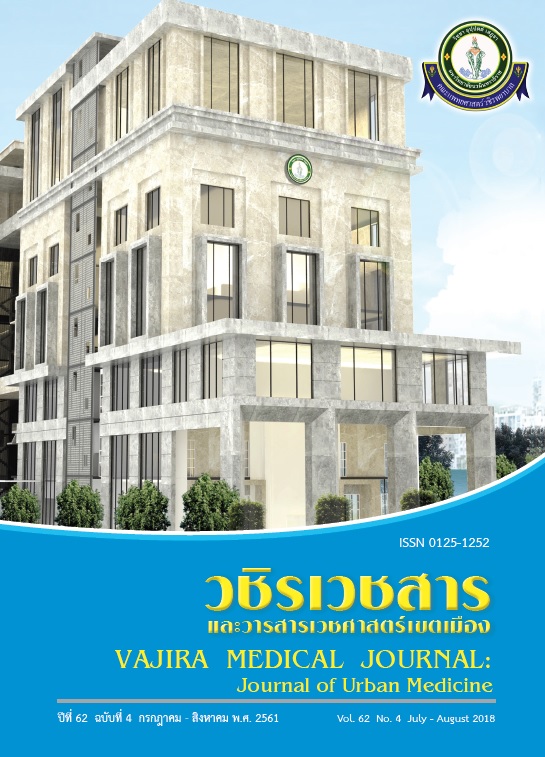Psychometric Properties of Falls Risk Assessment in Older People with Mild Cognitive Impairment and Dementia: A Systematic Review
Main Article Content
Abstract
Objective: To systematically review psychometric properties of falls risk assessment in older people with mild cognitive impairment (MCI) and dementia.
Methods: Electronic databases searched included PubMed, Science Direct, Cochrane and Web of Science for data collected from 1995 to September 2017. Inclusion criteria were older people over 60 years with mild cognitive impairment and dementia.
Results: The electronic databases searching yield 73 studies, 6 studies met the inclusion and passed quality assessments. Results for test-retest reliability were: Timed up and go test (TUG) (ICC 0.757 – 0.988), Five times sit to stand test (FTSTS) (ICC 0.94 – 0.97), Berg balance scale (BBS) (ICC 0.95), and Functional reach test (FRT) (ICC 0.81 – 0.84) Results for Intrarater reliability were: FRT (ICC 0.79), BBS and TUG (ICC 0.72). TUG had lowest standard error of measure (SEM) and minimal detectable change (MDC). Sensitivity and specificity of measurement in those who fell were found only in TUG. TUG showed sensitivity of 23.6 and specificity of 91.6 in people with mild cognitive impairment.
Conclusion: TUG had the best scores of test-retest reliability and standard error of measure. Considering psychometric properties, among the four functional balance assessment tools, TUG would be the best assessment tool for measuring balance and falls risk in older people with mild cognitive impairment and dementia.
Downloads
Article Details
References
2. Suttanon P. Physical Therapy for Older People. Thammasat University Press; 2015.
3. Martin P, Adelina Comas-herrera, Martin Knapp, Maelenn Guerchet, Maria Karagiannidou. World Alzheimer Report 2015: The Global Impact of Dementia. An Analysis of Prevalence, Incidence, Cost and Trends; 2015.
4. Allan LM, Ballard CG, Rowan EN, Kenny RA. Incidence and prediction of falls in dementia: a prospective study in older people. PLoS One 2009; 4(5):e5521.
5. Shaw FE. Falls in Older People With Dementia.[internet]. Available at: https://www.healthplexus.net/files/content/2003/August/0607dementiafall.pdf. Retrieved October 1, 2017.
6. Tangen GG, Engedal K, Bergland A, Moger TA, Mengshoel AM. Relationships between balance and cognition in patients with subjective cognitive impairment, mild cognitive impairment, and Alzheimer disease. Phys Ther 2014; 94(8):1123-34.
7. Sibley KM, Straus SE, Inness EL, Salbach NM, Jaglal SB. Balance Assessment Practices and Use of Standardized Balance Measures Among Ontario Physical Therapists. Phys Ther 2011; 91(11):1583-91.
8. Langley FA, Mackintosh SFH. Functional Balance Assessment of Older Community Dwelling Adults: A Systematic Review of the Literature. J Allied Healh 2007; 5(4).
9. Gates S, Smith LA, Fisher JD, Lamb SE. Systematic review of accuracy of screening instruments for predicting fall risk among independently living older adults. J Rehabil Res Dev 2008; 45(8):1105-16.
10. Shumway-Cook A, Baldwin M, Polissar NL, Gruber W. Predicting the probability for falls in community-dwelling older adults. Phys Ther 1997; 77(8):812-9.
11. Barry E, Galvin R, Keogh C, Horgan F, Fahey T. Is the Timed Up and Go test a useful predictor of risk of falls in community dwelling older adults: a systematic review and meta-analysis. BMC Geriatr 2014;14:14.
12. Duncan PW, Studenski S, Chandler J, Prescott B. Functional reach: predictive validity in a sample of elderly male veterans. J Gerontol 1992;47(3):M93-8.
13. Buatois S, Miljkovic D, Manckoundia P, Gueguen R, Miget P, Vancon G, et al. Five times sit to stand test is a predictor of recurrent falls in healthy community-living subjects aged 65 and older. J Am Geriatr Soc 2008; 56(8):1575-7.
14. Moher D, Shamseer L, Clarke M, Ghersi D, Liberati A, Petticrew M, et al. Preferred reporting items for systematic review and meta-analysis protocols (PRISMA-P) 2015 statement. Syst Rev 2015; 4(1):1.
15. Petersen RC. Mild cognitive impairment as a diagnostic entity. J Intern Med 2004;256(3):183-94.
16. Vahia VN. Diagnostic and statistical manual of mental disorders 5: A quick glance. Indian J Psychiatry 2013; 55(3):220-3.
17. McKhann GM, Knopman DS, Chertkow H, Hyman BT, Jack CR, Jr., Kawas CH, et al. The diagnosis of dementia due to Alzheimer's disease: recommendations from the National Institute on Aging-Alzheimer's Association workgroups on diagnostic guidelines for Alzheimer's disease. Alzheimers Dement 2011; 7(3):263-9.
18. Cochrane Methods Working Group for Screening and Diagnostic Tests cited. How to review the evidence: systematic identification and review of the scientific literature. National Health and Medical Research Council 1999:62.
19. Thomas VS, Hageman PA. A preliminary study on the reliability of physical performance measures in older day-care center clients with dementia. Int Psychogeriatr 2002; 14(1):17-23.
20. Ries JD, Echternach JL, Nof L, Gagnon Blodgett M. Test-retest reliability and minimal detectable change scores for the timed "up & go" test, the six-minute walk test, and gait speed in people with Alzheimer disease. Phys Ther 2009; 89(6):569-79.
21. Suttanon P, Hill KD, Dodd KJ, Said CM. Retest reliability of balance and mobility measurements in people with mild to moderate Alzheimer's disease. Int Psychogeriatr 2011; 23(7):1152-9.
22. Blankevoort CG, van Heuvelen MJ, Scherder EJ. Reliability of six physical performance tests in older people with dementia. Phys Ther 2013; 93(1):69-78.
23. Muir-Hunter SW, Graham L, Montero Odasso M. Reliability of the Berg Balance Scale as a Clinical Measure of Balance in Community-Dwelling Older Adults with Mild to Moderate Alzheimer Disease: A Pilot Study. Physiother Can 2015; 67(3):255-62.
24. Rolenz E, Reneker JC. Validity of the 8-Foot Up and Go, Timed Up and Go, and Activities-Specific Balance Confidence Scale in older adults with and without cognitive impairment. J Rehabil Res Dev 2016; 53(4):511-8.


